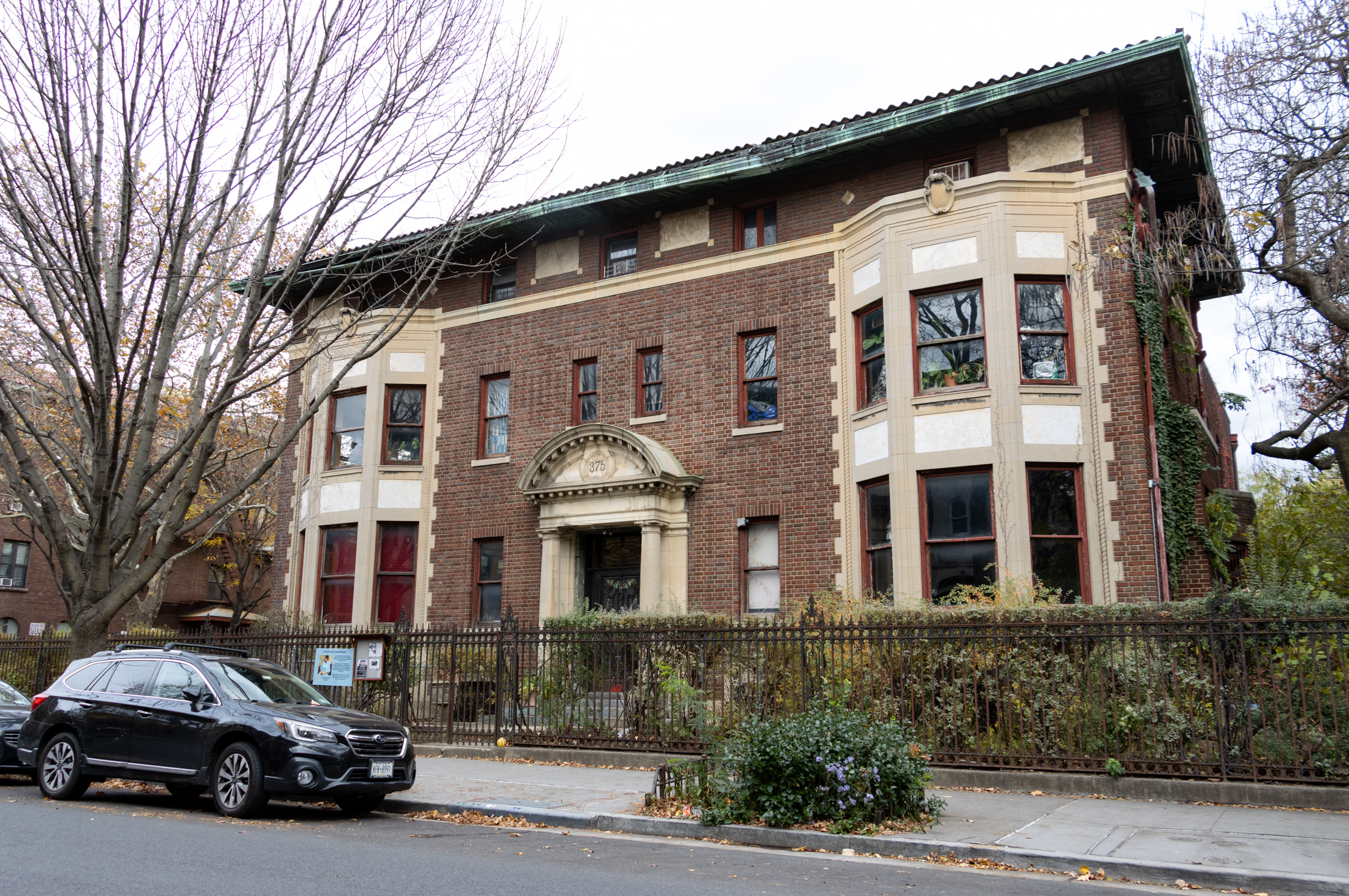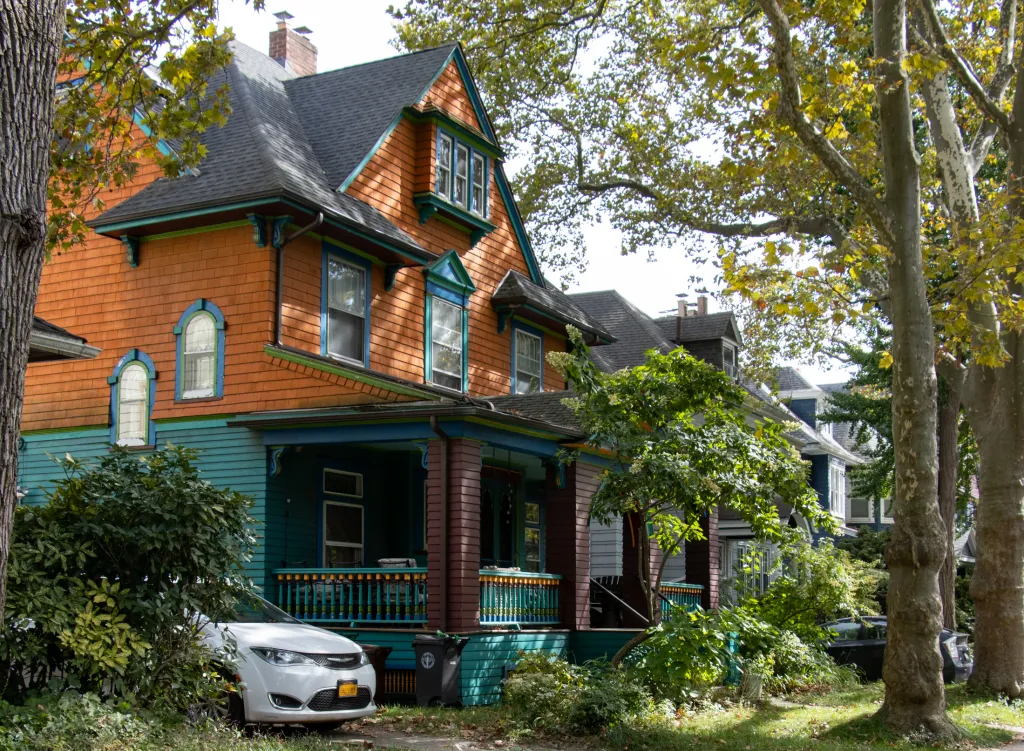Row Houses With a Twist: The Concrete Houses of Windsor Terrace
Thomas Sherman was a local developer who built quite a few houses in the neighborhoods of Windsor Terrace and Kensington.

Editor’s note: This story originally ran in 2014 and has been updated. You can read the previous post here.
These two sets of houses were brought to my attention by one of our readers. They are 715-725 and 801-811 Greenwood Avenue. They are separated by Sherman Street.
The reader was interested in the architecture of Windsor Terrace, especially these and other houses of the same general style. He had done some research on his own, and had come up with the name of the builder, Thomas B. Sherman. Sherman was working with a new building material here, the results being a new and modern take on a familiar row house form.

Thomas Sherman was a local developer who built quite a few houses in the neighborhoods of Windsor Terrace and Kensington. He shows up in the papers and building trades magazines building here and also on the other side of the park, in Prospect Heights, in the 1890s. He not only developed his properties, but acted as his own architect and builder.
He wasn’t one of the big guys, but he dealt with them, at one point buying property from William Reynolds, one of Brooklyn’s largest and most storied developers. After Reynolds had made his mark in Bedford Stuyvesant and Prospect Heights in the 1880s and ’90s, he moved south, picking up plots of land in Windsor Terrace, Kensington and Borough Park.

Sherman was unique in that he was working as a representative of a new and growing building material — concrete. This ancient building medium had been reintroduced in the late 19th century and had been especially touted for use in industrial buildings such as factories and warehouses.
Advances in reinforced concrete would usher in the age of the skyscrapers. In the meantime, as evidenced as early as in the Coignet Building in Gowanus, concrete could be mixed with materials that would make it indistinguishable from natural stone.
Builders began using it for row house construction in the early part of the century, especially in smaller elements such as lintels, doorways, frieze panels and other places where cast decorative elements would work as well as the old hand carved ones. Here, we see that going one step further — concrete cast as the building blocks themselves.

Sherman was the manager of the Hercules Perfection Pressed Stone Company, aka the Hercules Home Company, which had the same address as his home and development office. Hercules Stone was a brand name of a cast stone developed in the Midwest. It was created using tremendous amounts of pressure to remove all moisture and gaps, and create a building block that was, for all intents and purposes, stone. It was touted as fireproof, moisture-proof and the perfect building material.
Here in these Windsor Terrace homes, built between 1900 and 1909, we can see three different uses for the Hercules Stone. Sherman used a rough cut ashlar stone, a smooth faced stone, and the smooth carved panels for the lintels above the doorway and windows. This trim has now been reduced to a simple diamond carved in the center, a long way from the elaborate ornament found in limestones built at this same time.

The cornices still retain the most ornament, with simple floral patterns. Sherman uses the smooth stone faces as quoins, and wraps bands of alternating ashlar and smooth bricks around the corner buildings. He also uses a thick band of cement grout that looks like rope, giving the houses even more textural detail.
It is probably a coincidence that Thomas Sherman was building on or around Sherman Street. According to Brooklyn By Name, the street is named after Connecticut senator Roger Sherman, a signer of the Declaration of Independence and the Constitution, not Thomas. Whether they were related or not, I do not know. But Thomas Sherman had a lot on his plate, anyway.

He was in the building trades for many years, but seemed to go from boom to bust with his developments. He developed a block of homes shown in his ad in the Brooklyn Eagle Almanac of 1907, but lost them in foreclosure. He also lost his row of houses that may have included his own on Terrace Place in 1906.
Earlier in 1902 he had also lost another house he had developed at 22nd and Greenwood. There was still another lost at 60th and 13th Ave. He had awful luck, or just was a bad businessman. Putting his wife on the paperwork didn’t help either. Several of the cases named Minerva Sherman as well.

He stayed out of the papers for the most part, aside from the public notices of his foreclosures, except for one incident when another contractor had him arrested. In 1902, when he was 38, he got into a silly dispute over some boulders with another Brooklyn contractor. The contractor, Thomas Monahan, had a load of boulders sitting on 9th Avenue in Park Slope. Sherman sent over a crew to pick them up so he could crush them and use them in his foundations.
Naturally, Monahan had problems with that, and had him arrested. Sherman told both Monahan and the judge that the Brooklyn Rapid Transit Company had given him rocks that were left over from one of their nearby track projects. Sherman assumed these were his rocks and proceeded to take them. His men were only taking his property. Monahan disagreed. The rocks cost about $2, and the judge ordered Sherman to stop, but he also tossed out the case. Some stone is just stone, and should be left alone.

Many thanks to J. Garchik for his suggestion. Windsor Terrace is a hard neighborhood to research, and I appreciate the suggestions and the help. I hope you like the story.
[Photos by Susan De Vries unless noted otherwise]
Related Stories
- The Little Fortress Watching Over Windsor Terrace Since 1896
- From Innovation to Restoration: The Remarkable History of Gowanus’ Coignet Building
- Bridging Nature With New Technology: The Cleft Ridge Span of Prospect Park
Email tips@brownstoner.com with further comments, questions or tips. Follow Brownstoner on Twitter and Instagram, and like us on Facebook.





What's Your Take? Leave a Comment